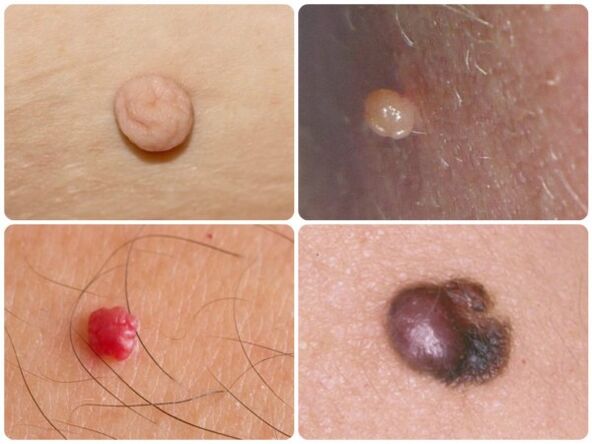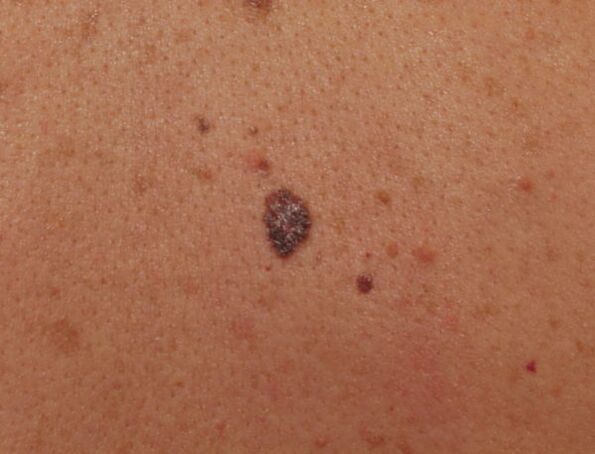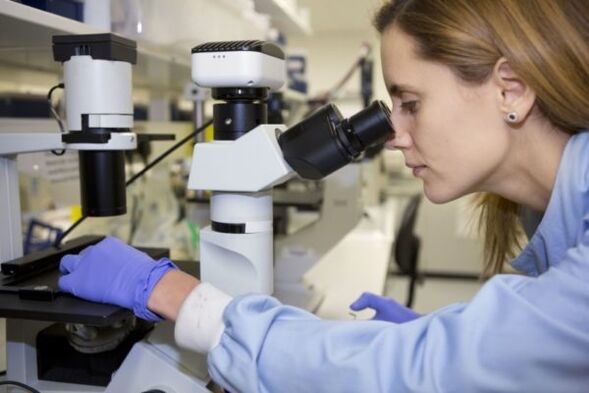Neck papilloma does not cause significant discomfort, but it can ruin the appearance. These tumors grow when the human papillomavirus (HPV) enters the body. The only exception is growths, which are often damaged. In order to get rid of the neck papilloma, special (usually surgical) intervention is required.

reason
Papilloma is a benign tumor caused by HPV infection. Doctors have isolated more than one hundred viruses that can cause such growths in the body. Overhanging warts of small size often appear on the neck, up to 2-3 cm in diameter.
Human papillomavirus infection occurs through direct contact with HPV carriers. It is also possible to spread pathogens through personal hygiene products or clothing. The virus can enter a child's body in the womb or during childbirth.
The possibility of papilloma depends directly on the immune status. As the body's defenses are weakened, the first growth will appear a few days after infection.

Causes of tumors in the neck include:
- Often damage the skin epithelium;
- Allergic reactions;
- high pressure;
- Respiratory diseases, worm invasion;
- Long-term use of multiple drugs;
- overweight;
- bad habits;
- Failure to comply with hygiene rules.
In women, hormonal imbalances during pregnancy, menopause or taking birth control pills are considered to be one of the common causes of neoplasms.
If there is a small growth in the neck, it usually does not require special treatment. In the absence of exposure to predisposing factors, such warts will disappear within three years without external intervention.

Types and symptoms
In all types of papilloma in the neck, the following types of growth will occur:
- Filamentous-Looks like small bumps on a yellow surface. In the future, there will be a leg, through which the growth attaches to the skin. Filamentous papillomas are flesh-colored or light brown.
- flat-This type of formation slightly protrudes from the surface of the cervix. The color of flat growth is no different from the color of adjacent tissues. Over time, they merge with each other, thereby increasing the affected area and sometimes itching.
- Corneal papilloma-Mainly occurs in people over 30 years of age, in a circular or longitudinal shape.
- Seborrheic-Characterized by the presence of a flaky surface. These growths are usually painful.
- Simple (vulgar)-This type of papilloma is located in the upper limbs, but sometimes it also grows on the neck or face. The growth looks like a round wart, prominently protruding above the skin.
Most papillomas are single. However, when the affected area is injured or immunity is rapidly weakened, the virus will spread to new areas, leading to the appearance of multiple tumors.

The growth of papilloma is not accompanied by serious symptoms. In rare cases, the activity of the virus can cause:
- Itching;
- combustion;
- pain.
When the problem area is injured, the affected area begins to bleed.
Possible consequences
Complications caused by the activity of the papillomavirus are usually caused by the behavior of the infected carrier. Frequent damage to growth can lead to:
- The development of papillomatosis. This pathology is characterized by the formation of multiple growths in a small area of the body. In extreme cases, the entire cervical area will be affected. This is because each wart contains the smallest virus particles, and when the tumor is injured, the virus will spread to the healthy area.
- Degenerate into a malignant tumor. Malignant tumors are also more common in tumor trauma. The injury leads to the development of an inflammatory process in the problem area.

Neck papilloma is more susceptible to external influences, so it can form open wounds on the skin. Because of this, the affected area is often infected by pathogenic bacteria, causing inflammation and suppuration of the epidermis.
Therefore, if the wart comes off and begins to bleed in the problem area, it is necessary to treat the damaged skin with an antiseptic composition and seal it with an antiseptic cream. In addition, it is recommended to consult a dermatologist within two to three days to rule out the possibility of complications.
diagnosis
Papillomavirus causes characteristic growth. However, in some cases, it is impossible to distinguish warts from other similar tumors.
In order to rule out other diseases in the form of rashes, perform the following diagnostic measures:
- PCR (polymerase chain reaction). It can not only diagnose the presence of viruses in the body, but also assess the possibility of tumor regression.
- Histological analysis. It is used to suspect malignant tumors.

The Digine test is considered more effective. This method is highly sensitive and can provide information about the presence of papillomavirus, the infection strain, and the degree of carcinogenesis.
Treatment technique
To remove the papilloma in the neck, you need to see a dermatologist. It is not recommended to work independently to remove tumors from the skin. This is especially true in the case of multiple tissue damage, which indicates a state of immunodeficiency.
In the treatment of papillomavirus, hardware technology and drugs are used. The latter can cope well with small-scale single growth.
medical treatement
Drug treatment is mainly carried out through the use of topical preparations.
To quickly remove neck warts, you can use special pharmacy products.
The use of medications does not always help to get rid of the papilloma. Moreover, this treatment method does not rule out the possibility that the tumors appear in the same place.
Hardware technology
To remove the papilloma from the neck, use the following hardware removal techniques:
- Laser coagulation-Allows you to remove tumors on the skin with minimal risk of infection or bleeding.
- Low temperature destruction-The program stipulates that the problem area should be treated with liquid nitrogen, which will destroy tumor cells.
- Electrocoagulation-Removal of tumors by exposure to high-frequency currents. This method is more painful than previously described.
- Radio wave removal-This method can not only remove the tumor, but also remove the tissue for subsequent histological examination.
In rare cases, the tumor is removed from the neck by surgery.
National Science
Family therapy can be done with folk remedies. Not only do they help remove the smallest tumors, but they are also effective in fighting large tumors.

Coping with cervical papilloma will help:
- Olive oil or castor oil. Using this tool, the problem area needs to be lubricated several times a day;
- Apple cider vinegar or ammonia. Any one of these funds must be applied to the cotton swab first and applied for a few minutes as it accumulates. This procedure should not be more than once a day;
- Aloe vera juice. They need to soak a cotton swab, apply it to the problem area and keep it for 4-5 hours;
- Tea tree oil. It is enough to apply two drops of the product on the skin tumor every day;
- Celandine tincture. To prepare it, you need to mix plant juice and water in equal proportions. The product is infused in a dark place for two weeks. The resulting drug should be taken every day, 15 drops.
Regardless of the method chosen against the papillomavirus, treatment must be supplemented by measures aimed at enhancing immunity. For this reason, it is recommended to take vitamin complexes and immunomodulators. In traditional medicine, herbal decoctions of lemon balm, plantain, dandelion root and other plants help strengthen the immune system.
prevention
It is quite difficult to prevent human papillomavirus infection. However, if you follow the rules of prevention, you can avoid tumors in your body. this needs:
- Wash hands and body every day;
- Healthy Food;
- Treat the disease promptly;
- Reject bad habits;
- Live an active and healthy lifestyle.
If warts appear on the neck, it is recommended to be checked by a doctor to rule out malignant tumors. If the wart has changed color or has multiple growths on the skin, you must consult a dermatologist.























